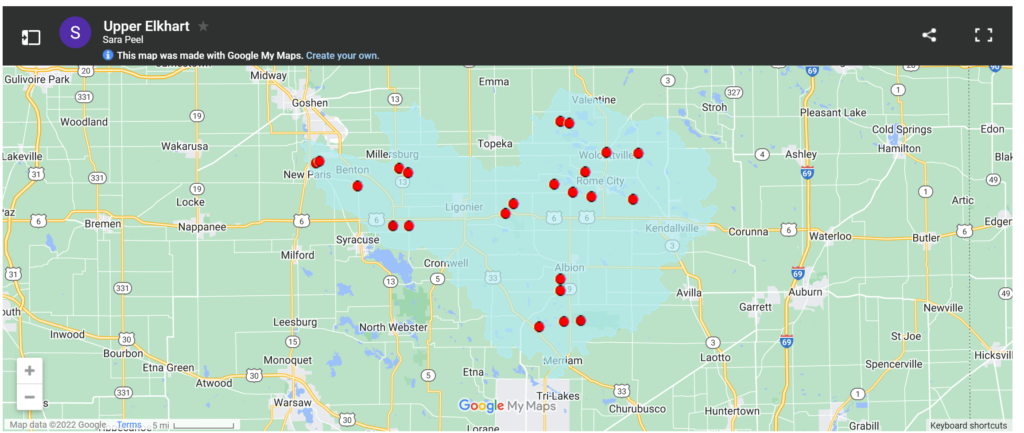In 2020, the Elkhart River Restoration Association launched efforts to protect and improve the Upper Elkhart River Watershed. This effort focuses on updating the Elkhart River Watershed Management Plan for the upper portion of the Elkhart River basin. The Upper Elkhart River Watershed drains 402 square miles including portions of Kosciusko, Lagrange, Elkhart and Noble counties.
What is a watershed?
The Upper Elkhart River Watershed Project focuses on protecting and improving water quality in the Upper Elkhart River Watershed. All of the land from which water drains into a singular waterbody forms a watershed. These drainage boundaries are determined by land elevation rather than state or county lines, political boundaries, or residential property lines. View the Elkhart River Watershed Map.
About the Upper Elkhart River Watershed
The Upper Elkhart River Watershed drains portions of Kosciusko, Lagrange, Elkhart and Noble Counties (403 sq mi) and includes three 10-digit HUCs. More than 539 miles of streams are present in the watershed. Impairments include: 184.3 mi E. coli, 72.7 mi for biotic communities, 17.0 mi for dissolved oxygen, 10.2 mi for nutrients, and 10.2 mi for chloride. Additionally, lake impairments include phosphorus (9), biotic communities (9) and mercury or PCBs in fish tissue (6). Based on 2016 land cover data (NLCD), nearly 60% of the watershed is in agricultural row crops (corn-soybean) with 7% in pasture, 22% in forested or wetland land uses, 9% urban and 2% open water. Based on data compiled as part of the 2008 WMP, nutrients, sediment and E. coli are the primary nonpoint source concerns in the Elkhart Watershed. Using models, the plan identified loading rates of 2.1mil tons P, 2.1mil tons N, 2.1mil tons TSS and 5.1E+13col E. coli in the Upper Watershed.
Historic water quality data collected (2002-2019) by IDEM, USGS, Elkhart County Health Dept (HD), Hoosier Riverwatch volunteers and consultants (LARE, 319 projects) indicate that 79% of N, 81% of TP, 64% of TSS, 78% of turbidity, 12% of pH, 8% of DO and 77% of E. coli samples exceed water quality targets or state standards. The Elkhart County HD notes that the Elkhart River routinely contains E. coli concentrations above the state standard and those tributary concentrations measure higher than the mainstem. Sources of elevated nutrients, excess sediment and pathogen concentrations in excess of state standards originate from agricultural and urban sources.
Goals for the Upper Elkhart River Project
Read the APPROVED Watershed Management Plan HERE
View the Presentation from the Final WMP Public Meeting HERE
